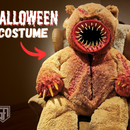Introduction: Lazy Susan 2.0 (Sushi Train)
I made this sushi train to fix a problem that I experienced when I moved to Norway.
The problem was the Norwegian Arm. What is the Norwegian arm? Well… Norwegian think it's impolite to use “words” to ask for things so they reach across the table and even stand up to get what they want. It's a horrific experience. Trust me.
I had engineered my way out of problems before. So I made this sushi train to disarm the repulsive Norwegian arm and revert meal times in Norway back to a civilised dining experience.
Supplies
Supplies?? this is a hard one. My wife cracked down on my spending so I had to create this thing with what I could find in my garage and in the trash.
The crux of it is that you need some plywood, some screws, a stepper motor, a hell of a lot of patience and a sense of humor.
Step 1: Prototyping
Prototyping
Before you go ahead and start this project. You might want to make a couple of prototypes. Especially if you are using different materials, from my project.
My first few prototypes failed big time.
In the end I decided to go with this wooden chain type arrangement..
Step 2: The Carriages
The Carriages
A carriage is made up of three parts. The moon shaped top, the middle Gear pinion, and the pinion tail. As you can see from these poorly drawn drawings that I did in paint. There you can also get some measurements.
I first initially started cutting these out using a copy bit on the inverted table router. Or as I like to call it the Inverted Spinning Death Machine.
This turned out to be way too dangerous especially when copying the small parts. So I was forced to reach out to my friend, so that I could borrow his CNC.
After cutting all your parts out. You will need to clean them up and then you'll be ready for assembly. (From memory it think this was 280 separate parts. Do your own calculation depending how big you want your sushi train to be.)
Step 3: Carriage Assembly
Carriage assembly
I built a crappy alignment jig to align my three pieces so that they were not off-center. As that would really screw everything up. Then it's as simple as gluing together the parts with some wood glue and using a small nail gun. To nail them together holding them in the right position, whilst the glue dries.
I didn't know it at this point but I was going to have to modify these carriages so that the dishes didn't fall off the sushi train. I had the displeasure of disassembling the whole thing just so that I could fix this problem. Don't do that. Be smarter than me and fix this problem now.
I fixed this problem by cutting a recess on the outer edge of the top and gluing a paddle pop stick in the recess with approximately 5 mm above the edge.
Once all the carriages are finished you can then screw them together using a 3x30 mm screw then backing it off just half a turn so that it pivots easily.
There you go. The biggest Tokyo gangster chain you could ever want.
Step 4: Drive Gears
The Drive Gears
The drive gears were one of the hardest bits to work out as I'm not really a smart man. Let’s be honest.
In the end. I did this by working out the radius that I wanted at each end then laid some of the sushi train carriages (without the top moon) along the circumference. Marking where the gear teeth would engage. With some adjustment. I cut 1 Gear out as a prototype. Sanding down the teeth where required, to make it work smoothly. I then used it as a template for the other gear.
I also stole some bearings from my sons skateboard (sorry champ) and pressure fit them in to the center of the gear. To help reduce friction. This is important as you will understand in the next step.
Step 5: The Motor & Motor Control
The motor and motor control
I had a 5-volt stepper motor lying around. The problem was that it couldn't pull the skin off a rice pudding, but it's all I had.
I needed to increase the torque of this motor so I used what I had which was my son's little electric police motorcycle (sorry again champ). I pulled the gearbox out of this and replaced the small electric motor with my stepper motor. The way I attached the gears to the motor increased the output torque by around 30 times which was just enough for this project.
Your best bet is to get a stepper motor that is strong enough to spin the thing without any gearbox.
Using a Wemos D1 Mini I stole some code from another YouTuber. That's what's so great about Arduino so many people do so many amazing things and it's all free and acceptable to rip off someone else's code. So make sure you learn and steal some Arduino coding.
To power it all you’ll need a 5 volt power supply. Most USB chargers will suffice but in my case I had a 12-volt power supply which I converted down to 5 volts. The 5 volts Powers the motor and motor controller (whose name I forget but if you've got a stepper motor you'll need one of those.)
To control the motor I used a programmable App called Blynk. It is a super intuitive app, which is super easy to use. I don't know how it works but it must be pure freaking magic. Regardless I had this up and running within minutes. I programmed a clockwise and anticlockwise direction button along with a speed control slider. My kids were impressed.
Here is the code if you want to "borrow" it.
#include <Stepper.h>
#include <ESP8266WiFi.h>
#include <BlynkSimpleEsp8266.h>
#define BLYNK_PRINT Serial
Stepper my_Stepper(200, D3, D4);
bool Right = false;
bool Left = false;
int Speed = 10;
char auth[] = " Lrz3SG1jC-KA1y6_GuxWECIfDaRka2mH";
char ssid[] = "wifiname"; // write wifi network name here//
char pass[] = "password"; // writ wifi password here //
void setup(){
Serial.begin(9600); // baudrate for serial comunication
Blynk.begin(auth, ssid, pass); // network information
my_Stepper.setSpeed(10); // Speed for stepper motor
}
BLYNK_WRITE(V1){ // read input from virtual pin V1
Right = param.asInt(); // assigning incoming value from pin V§1 to a variable
}
BLYNK_WRITE(V2){ // read input from virtual pin V2
Left = param.asInt(); // assigning incoming value from pin V0 to a variable
}
BLYNK_WRITE(V3){
Speed = param.asInt();
}
/*void Stepper1 (int Direction, int Rotation){ // function for stepper motor control with 2 parameters
for (int i = 0; i < Rotation; i++){ // for loop
my_Stepper.step(Direction * 200); // 200 is 360 degree => change value if smaller then 360 degree is needing
Blynk.run();
my_Stepper.setSpeed(Speed);
}
}
*/
void Stepper1 (int Direction, int Rotation){ // function for stepper motor control with 2 parameters
while (Right){
my_Stepper.setSpeed(Speed);
my_Stepper.step (-1);
Blynk.run();
delay (1);
}
while (Left){
my_Stepper.setSpeed(Speed);
my_Stepper.step (1);
Blynk.run();
delay (1);
}
}
void loop() {
Blynk.run();
if (Right){ // if condition
Stepper1(1, 10); // steppermotor rotates 10 times 360 degree right
Serial.println("Right turn");
}
delay(10); // delay 20ms
if (Left){ // if condition
Stepper1(-1, 10); // steppermotor rotates 10 times 360 degree left
Serial.println("Left turn");
}
delay(10); // delay 20ms
}
Step 6: The Under Carriage
The Under Carriage
Building an undercarriage was a little bit like trial by fire. Essentially you're gonna need some more plywood. I use the sheet of plywood as the base and cut recesses where required. eg. where the bolts of the gear axles needed to be accessed or or where the motor and other components required to be positioned lower.
To tension the chain. I made a sliding mechanism from plywood. This is where the trail Gear was able to be adjusted depending on how much tension was required.
To support the sushi train in between the two gears I made this guide out of two pieces of plywood and a spacer. Being that my wife was so strict and had my wallet in her handbag I was required to think creatively. So I came up with this ingenious idea to not "spend" money but to "use" money as wheels or bearings. Allowing the chain to roll freely on top of the undercarriage. The Norwegian one krone coin was perfect as it already had a hole drilled in it. I was going to need a bit more than the 7 krones in my daughter's piggy bank though. So I made a post on social media and to my surprise the Norwegians came through. I mean I had people knocking on my door at 7am handing over what others would consider a days wages. I am so grateful. I fixed the coins in place using a 3x16mm screw evenly placed along the inside and outside edges.
To finish the under carriage. At each end I mitered 4 pieces of wood to make half of a …..what is a 8-sided shape called again? Octagon!! God damn it. Nevertheless I join them together using biscuits and screwed them down to each end through the base plate.
Step 7: Coating
Coating
I disassembled everything and then coated it all in Osmo white oil. It’s pretty simple stuff to use. Just make sure you where gloves don't sniff too much of it, as you might enjoy yourself too much.
Step 8: Final Assembly
Final Assembly
Once all your components are dry... it's as simple as screwing everything back into place. Tension up the chain. Find a place to install your electronic components. Of course making sure that they are not positioned to get damaged by any moving parts.
Then the final touch is the top cover over. This will cover the drive gears and hides the electronics. You will need to make sure you position it about 5 mm above the same as the paddle pop sticks. This will stop your dishes from sliding inwards.
And Hey presto! You've created possibly the most overcomplicated Lazy Susan in the world.

Second Prize in the
Anything Goes Contest 2021













